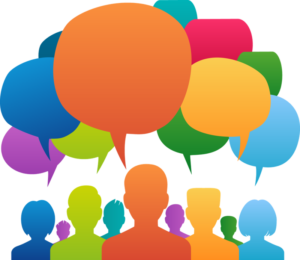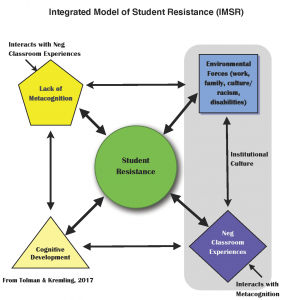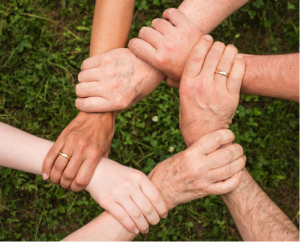by Gina Burkart, Ed.D., Learning Specialist, Clarke University
 Prior to the pandemic and now since returning to campus, there has been a shift in students’ use of group study and ability to learn and work in groups. When I began my position as Learning Specialist 10 years ago, it was not uncommon to find 30 students at group study sessions at 9 pm in the evening. Now, one group study session remains, and 2-3 students might attend the sessions (unless they are teams’ sessions required by athletic coaches). Colleagues have also shared in conversations that they have found it problematic that students avoid interacting with one another in the classroom and are not able to work and learn in physical groups. Further in my learning resource center year-end reports, data have shown a steady decline in group study attendance and a steady increase of students relying on support from me, the Learning Specialist. They want to work one/one with adults. In conversations with students and in online discussion blogs, students’ have shared a lack of inter- and intrapersonal communication skills as affecting their ability to work with their peers. In simple terms—overuse of electronic communication pre-pandemic and during the pandemic has left them unable to communicate interact with their classmates. This is problematic for a variety of reasons. In terms of learning, pedagogy is clear—learning is social (Bandura, 1977).
Prior to the pandemic and now since returning to campus, there has been a shift in students’ use of group study and ability to learn and work in groups. When I began my position as Learning Specialist 10 years ago, it was not uncommon to find 30 students at group study sessions at 9 pm in the evening. Now, one group study session remains, and 2-3 students might attend the sessions (unless they are teams’ sessions required by athletic coaches). Colleagues have also shared in conversations that they have found it problematic that students avoid interacting with one another in the classroom and are not able to work and learn in physical groups. Further in my learning resource center year-end reports, data have shown a steady decline in group study attendance and a steady increase of students relying on support from me, the Learning Specialist. They want to work one/one with adults. In conversations with students and in online discussion blogs, students’ have shared a lack of inter- and intrapersonal communication skills as affecting their ability to work with their peers. In simple terms—overuse of electronic communication pre-pandemic and during the pandemic has left them unable to communicate interact with their classmates. This is problematic for a variety of reasons. In terms of learning, pedagogy is clear—learning is social (Bandura, 1977).
An Assignment to Reinforce Social Learning and Metacognition
In response, this semester, to reinforce social learning and metacognition, I changed the final assessment for the College Study Strategy course to be a final presentation that embedded metacognition and social discourse. The College Study Strategy course is metacognitive in nature in that it begins by having students reflect on their prior learning experiences, assess themselves and their skills, and set goals for the semester. It is a 1-credit course open to any student below 90 credits and can be retaken. However, in the second semester, it is almost entirely filled with students placed on academic probation or warning who are required to take the course. Curriculum includes theorists such as Marzano (2001), Bandura (1994), Ducksworth (2013), Dweck (2014), and Covey (2004) and requires them to begin applying new motivation, emotional intelligence, learning, reading, time management, study, note-taking, and test-taking strategies to their courses. In the past, students created a portfolio that demonstrated the use of their new strategies and presented their growth to me in a midterm and final conference. This year, I wanted them to share their new growth with more than me—I wanted them to share their growth with the entire community.
By changing the final project to be more outward-facing, the assignment would still be metacognitive in nature—requiring students to reflect on past learning, show how they made adjustments to learning and applied new methods and strategies, share in conversation how they made the adjustments, and finally explain how they will continue to apply strategies and continue their growth in the future with the new knowledge and strategies. Again, it would require students to share with more than me. They would need to envision a larger audience and needs—the entire campus community (administrators, students, Athletic coaches, staff, professors, recruits) and create a presentation that could be adjusted to the audience. They would practice inter and intra-personal skills as they made adjustments to their presentation over the course of 2 hours while they remained at station in the library, prepared to share their presentation as members of the campus community approached. This also allowed for the campus community to benefit from the students’ new knowledge and growth of the semester. And, being on a small scale, it re-introduced students to the art of in-person, face-face conversation between each other and the value of seeking information from each other. This is something that has been eroding due to a heavy use of electronic communication and isolated learning that occurred during the pandemic.
Students were introduced to this assignment in week one of the semester. They were told that in week 6 they would choose any topic from the course curriculum that they felt they needed to focus on more intently based on their semester goals. Once choosing the curriculum they would focus on (ex: motivation, reading, procrastination, time management, studying, growth mindset), they would then research a different article each week related to their chosen topic (weeks 6-12) and apply the new critical reading strategy taught in class to create journal entries that would be used to prepare content for the final presentation. In weeks 14 or 15, they would present in the library at a table (poster session style) during a time of their choosing (two-hour block) to the campus community about their topic. The presentation needed to include some type of visual and the content needed to include all of the following metacognitive information about the topic:
- past struggles
- reasons for choosing the topic
- strategies learned in class
- information learned in their research
- recommendations for other students struggling
- strategies for continued growth
Positive Impact and Take-Aways
While students were nervous and hesitant prior to the presentations, during and after the presentations, they admitted to having fun sharing about their growth and learning. Staff, faculty, and students were also appreciative of the presentations and made a point of attending. Some future students/recruits even attended as they were touring. Not surprising, most students chose to present about motivation, time management and procrastination. A few students chose to present about growth mindset, Bloom’s Taxonomy as a study strategy, and reading. A surprising take-away was that in the metacognitive process of the presentation, many students connected improved reading strategies to increased motivation and reduction in procrastination.
While observing the presentations, it was encouraging to see students learn to adapt their presentations as people approached. Since they were stationed at a table for two hours, they needed to present the material many times to different types of audiences—and they had to field questions. As they presented and represented, they learned how to interact and present differently based on the needs of the audience. This adaptation required the use of metacognition and rhetorical analysis. It also built inter- and intrapersonal communication skills. It also came at a good time in the semester, as students were authentically seeking many of the strategies and skills to prepare for finals, conclude the semester, and look forward to the next semester. Many of the presenters had friends and team members, coaches, and faculty come to hear their presentations (as I had advertised the presentations to the campus in advance). In conclusion, metacognitive presentations that engage the entire campus community in discourse about learning may be a helpful step toward rebuilding learning communities post-pandemic. Next semester, I will continue this assignment. Additionally, next semester, I am working on embedding group reading labs into targeted courses to improve learning, motivation and reduce procrastination in the classroom.


